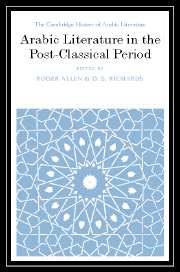Book contents
- Frontmatter
- The post-classical period: parameters and preliminaries
- Part I Elite Poetry
- 1 Arabic poetry in the post-classical age
- 2 Poetic creativity in the sixteenth to eighteenth centuries
- 3 Arabic religious poetry, 1200–1800
- 4 The role of the pre-modern: the generic characteristics of the band
- Part II Elite prose
- Part III Popular poetry
- Part IV Popular prose
- Part V Drama
- Part VI Criticism
- Bibliography
- Index
- References
4 - The role of the pre-modern: the generic characteristics of the band
from Part I - Elite Poetry
Published online by Cambridge University Press: 28 March 2008
- Frontmatter
- The post-classical period: parameters and preliminaries
- Part I Elite Poetry
- 1 Arabic poetry in the post-classical age
- 2 Poetic creativity in the sixteenth to eighteenth centuries
- 3 Arabic religious poetry, 1200–1800
- 4 The role of the pre-modern: the generic characteristics of the band
- Part II Elite prose
- Part III Popular poetry
- Part IV Popular prose
- Part V Drama
- Part VI Criticism
- Bibliography
- Index
- References
Summary
introduction
The processes of cultural change that affected the world of Arabic literature during the fifth/eleventh century reflect a situation in which certain cultural forms chose to remain aloof from all events and trends connected with modernization. As a result, other forms of expression, ones that were in closer contact with such events and trends and could thus give them expression, came into existence. It was at this time that a variety of sub-genres of poetry emerged, including the muwashshah and zajalin Spain, ‘arūd al-baladin the Maghrib, mawāliya, qūmā, kan wa-kān, dūbayt in the eastern regions (especially Iraq) and sung poetry called al-humaynī in Yemen (these genres are discussed in greater detail in Larkin’s contribution to this volume, Chapter 10). These were all modernist genres, or, to cite Ibn Khaldūn’s term for them, muwallada. It is precisely the general cultural influences that led to the appearance of these genres of expression that are also responsible for the emergence of the band genre as a new mode of expression.
The bandis considered one of the literary modes of expression that emerged during the period of major cultural decentralization that early Arabic literature witnessed. The process engendered local cultural phenomena which, it would appear, were increasingly unwilling to tolerate the established norms of the higher culture. As a result, the band does not conform with many of the dicta of that higher culture regarding grammatical rules and discourse styles. Like the above-mentioned genres, the band did not conform with the rhythmical, stylistic or verbal structures that traditional Arabic literature had firmly established. Instead such structures were abandoned in favour of others that more closely matched the cultural environment that led to their very emergence.
- Type
- Chapter
- Information
- Arabic Literature in the Post-Classical Period , pp. 87 - 98Publisher: Cambridge University PressPrint publication year: 2006



